1999 NISSAN PRIMERA fuel pump
[x] Cancel search: fuel pumpPage 344 of 2267

CONSULT-II Reference Value in Data Monitor
Mode
Remarks:lSpecification data are reference values.lSpecification data are output/input values which are detected or supplied by the ECM at the connector.
* Specification data may not be directly related to their components signals/values/operations.
MONITOR ITEM CONDITION SPECIFICATION
CKPS×RPM (TDC)
lTachometer: ConnectlRun engine and compare tachometer indication with the CONSULT-II value.Almost the same speed as the CON-
SULT-II value.
CKPS×RPM-PUMP
COOLAN TEMP/S
lEngine: After warming up More than 70ÉC (158ÉF)
VHCL SPEED SE
lTurn drive wheels and compare speedometer indication with the CON-
SULT-II valueAlmost the same speed as
the CONSULT-II value
FUEL TEMP SEN
lEngine: After warming up More than 40ÉC (104 ÉF)
ACCEL POS SEN
lIgnition switch: ON
(Engine stopped)Accelerator pedal: release Approx. 0.40V
Accelerator pedal: depress Approx. 3.3V
OFF ACCEL POS
lIgnition switch: ON
(Engine stopped)Accelerator pedal: release ON
Accelerator pedal: slightly open OFF
C/SLEEV POS/S
lEngine: After warming up Approx. 2.5V
BATTERY VOLT
lIgnition switch: ON (Engine stopped) 11 - 14V
START SIGNAL
lIgnition switch: ON,START,ON OFF,ON,OFF
AIR COND SIG
lEngine: After warming up, idle the
engineAir conditioner switch: ªOFFº OFF
Air conditioner switch: ªONº
(Compressor operates.)ON
IGN SW
lIgnition switch: ON,OFF ON,OFF
MAS AIR/FL SE
lEngine: After warming uplAir conditioner switch: ªOFFºlShift lever: ªNºlNo-loadIdle 0.8 - 2.7V
2,000 rpm 2.2 - 2.8V
ACT INJ TIMG
lEngine: After warming uplAir conditioner switch: ªOFFºlShift lever: ªNºlNo-loadlAt sea levelIdle -0.5 to -1.5É
2,000 rpm +2.5É to +3.5É
TARGET F/INJ
lEngine: After warming uplAir conditioner switch: ªOFFºlShift lever: ªNºlNo-loadlAt sea levelIdle 8.0 - 8.8 mm
3/stroke
2,000 rpm Approx. 7.6 mm
3/stroke
BRAKE SW
lIgnition switch: ONBrake pedal: released OFF
Brake pedal: depressed ON
BRAKE SW 2
lIgnition switch: ONBrake pedal: released OFF
Brake pedal: depressed ON
FUEL CUT S/V
lIgnition switch: ON,OFF ON,OFF
AIR COND RLY
lAir conditioner switch: OFF,ON OFF,ON
GLOW RLY
lRefer to EC-CD-124.
COOLING FAN
lWhen cooling fan is stopped. OFF
lWhen cooling fan operates at low speed. LOW
lWhen cooling fan operates at high speed. HI
EGRC SOL/V A
lEngine: After warming uplAir conditioner switch: ªOFFºlShift lever: ªNºlNo-loadlAt sea levelIdle OFF
2,800 rpm ON
TROUBLE DIAGNOSIS Ð General DescriptionCD20T
EC-50
Page 371 of 2267
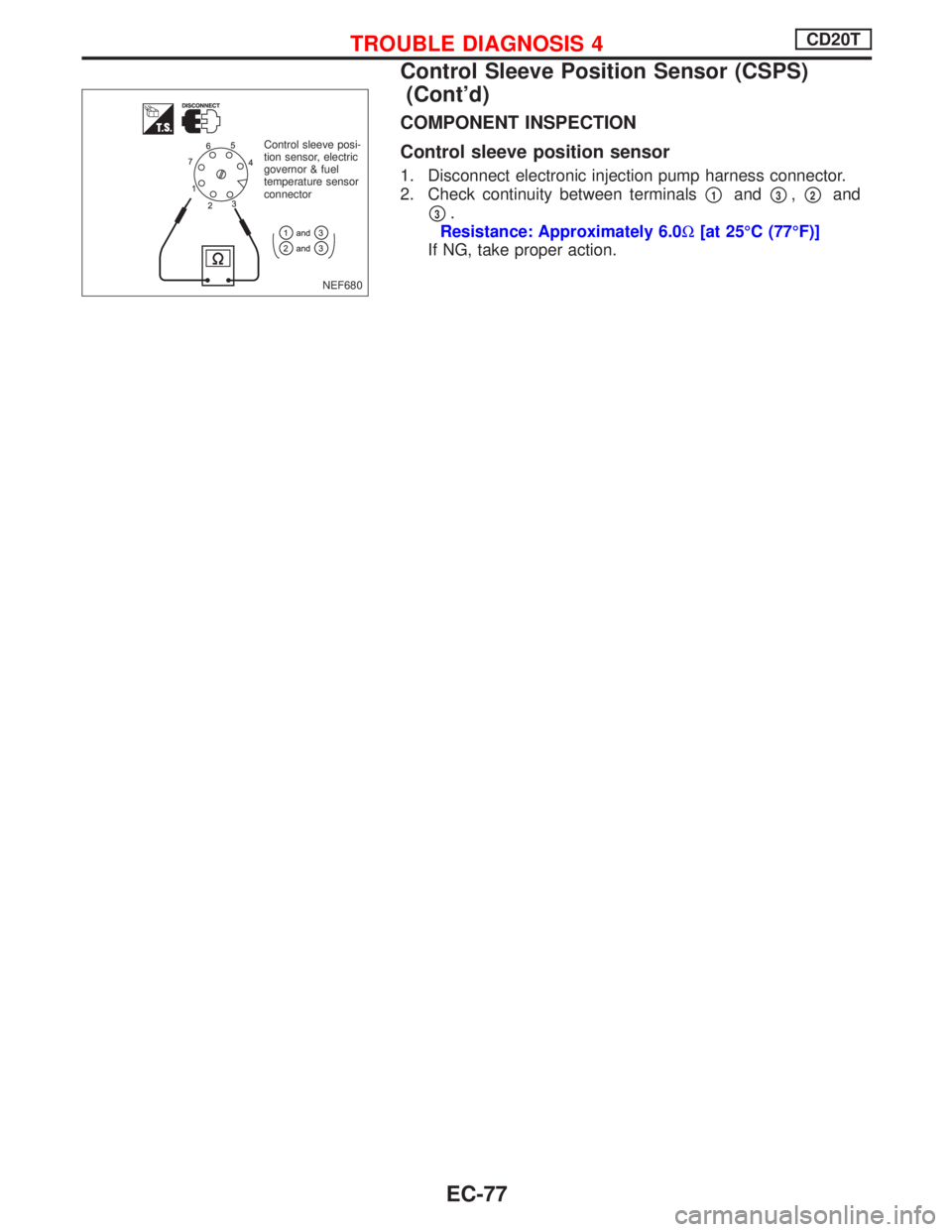
COMPONENT INSPECTION
Control sleeve position sensor
1. Disconnect electronic injection pump harness connector.
2. Check continuity between terminals
p1andp3,p2and
p3.
Resistance: Approximately 6.0W[at 25ÉC (77ÉF)]
If NG, take proper action.
NEF680 Control sleeve posi-
tion sensor, electric
governor & fuel
temperature sensor
connector
TROUBLE DIAGNOSIS 4CD20T
Control Sleeve Position Sensor (CSPS)
(Cont'd)
EC-77
Page 372 of 2267
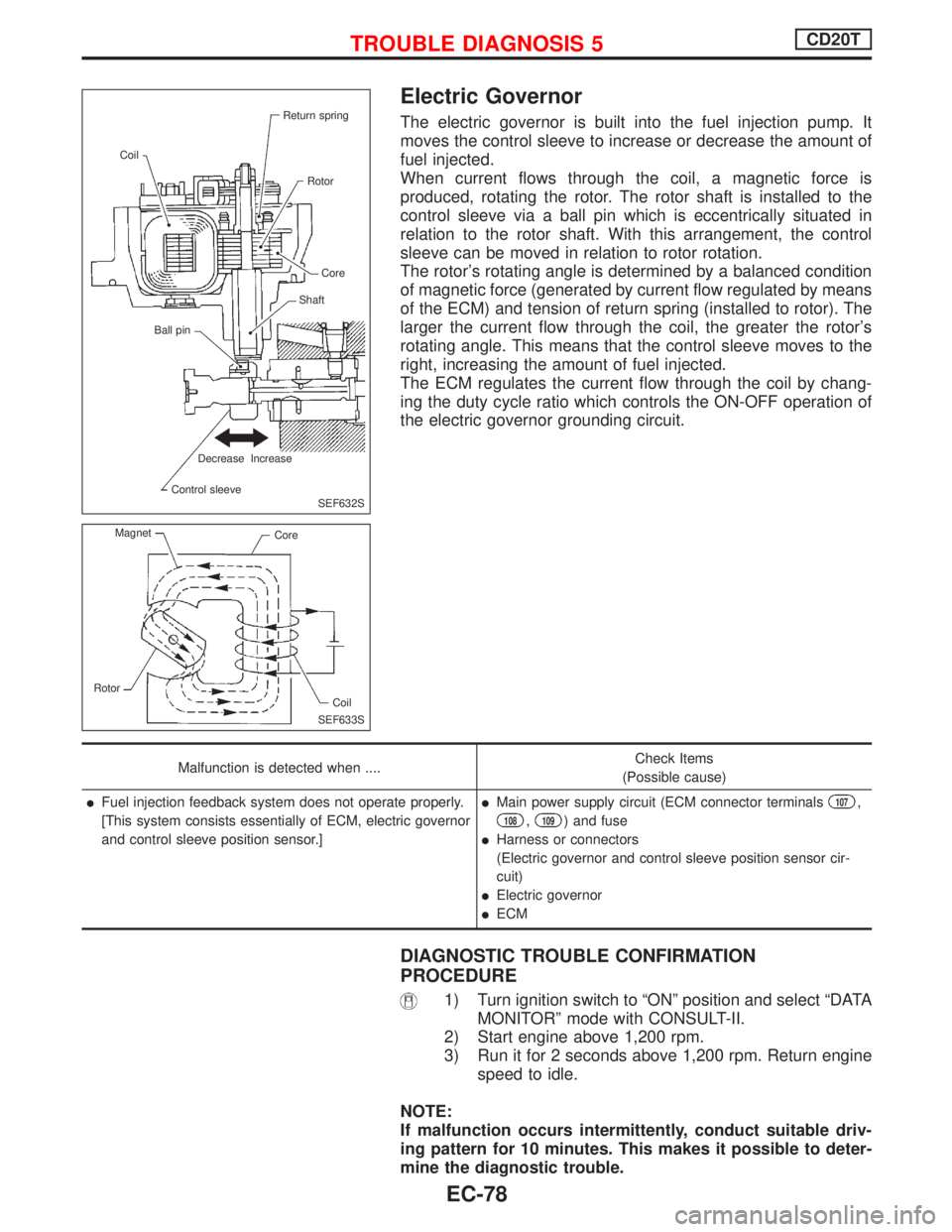
Electric Governor
The electric governor is built into the fuel injection pump. It
moves the control sleeve to increase or decrease the amount of
fuel injected.
When current flows through the coil, a magnetic force is
produced, rotating the rotor. The rotor shaft is installed to the
control sleeve via a ball pin which is eccentrically situated in
relation to the rotor shaft. With this arrangement, the control
sleeve can be moved in relation to rotor rotation.
The rotor's rotating angle is determined by a balanced condition
of magnetic force (generated by current flow regulated by means
of the ECM) and tension of return spring (installed to rotor). The
larger the current flow through the coil, the greater the rotor's
rotating angle. This means that the control sleeve moves to the
right, increasing the amount of fuel injected.
The ECM regulates the current flow through the coil by chang-
ing the duty cycle ratio which controls the ON-OFF operation of
the electric governor grounding circuit.
Malfunction is detected when ....Check Items
(Possible cause)
lFuel injection feedback system does not operate properly.
[This system consists essentially of ECM, electric governor
and control sleeve position sensor.]lMain power supply circuit (ECM connector terminals107,
108,109) and fuse
lHarness or connectors
(Electric governor and control sleeve position sensor cir-
cuit)
lElectric governor
lECM
DIAGNOSTIC TROUBLE CONFIRMATION
PROCEDURE
1) Turn ignition switch to ªONº position and select ªDATA
MONITORº mode with CONSULT-II.
2) Start engine above 1,200 rpm.
3) Run it for 2 seconds above 1,200 rpm. Return engine
speed to idle.
NOTE:
If malfunction occurs intermittently, conduct suitable driv-
ing pattern for 10 minutes. This makes it possible to deter-
mine the diagnostic trouble.
SEF632S Return spring
Coil
Rotor
Core
Shaft
Ball pin
Decrease Increase
Control sleeve
SEF633S Magnet
Core
Rotor
Coil
TROUBLE DIAGNOSIS 5CD20T
EC-78
Page 376 of 2267
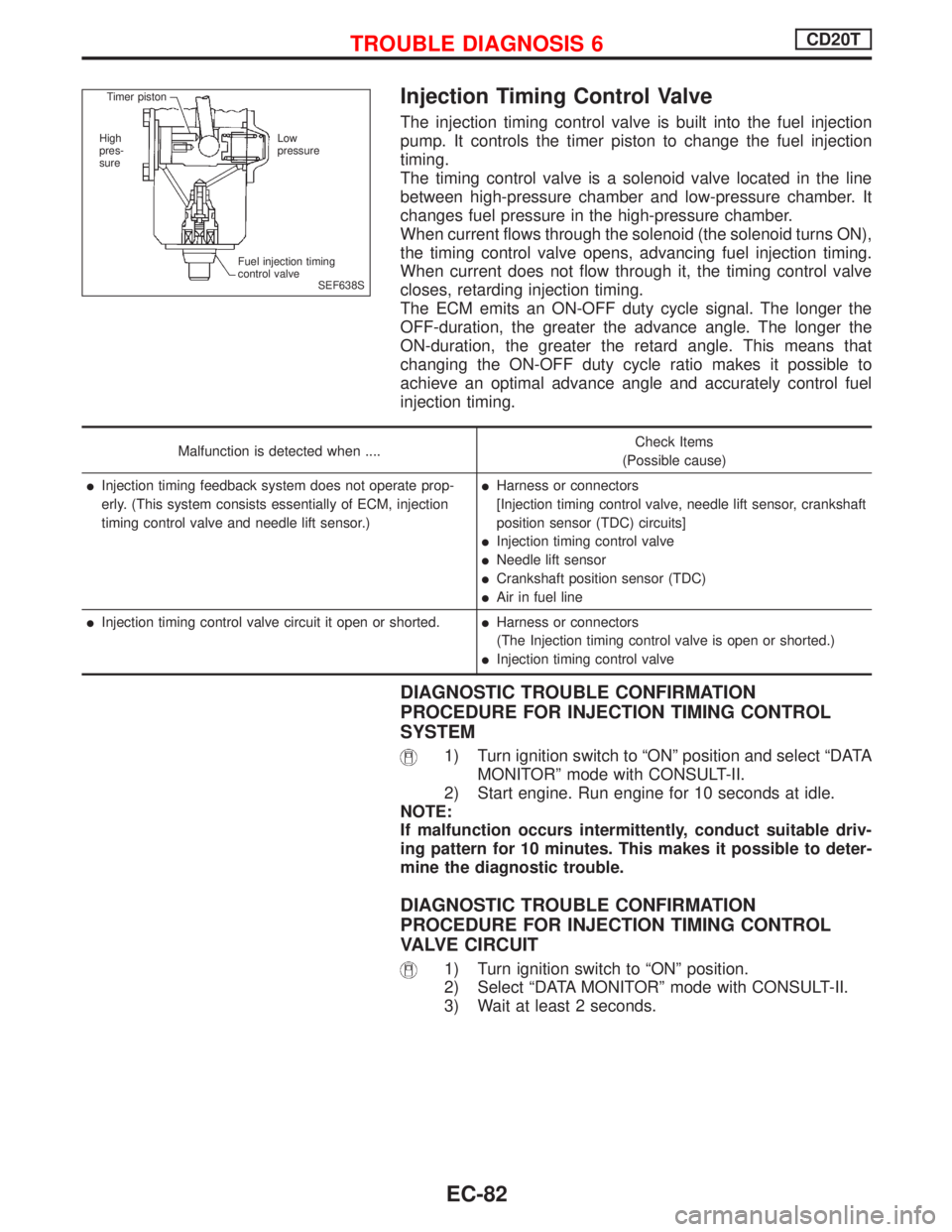
Injection Timing Control Valve
The injection timing control valve is built into the fuel injection
pump. It controls the timer piston to change the fuel injection
timing.
The timing control valve is a solenoid valve located in the line
between high-pressure chamber and low-pressure chamber. It
changes fuel pressure in the high-pressure chamber.
When current flows through the solenoid (the solenoid turns ON),
the timing control valve opens, advancing fuel injection timing.
When current does not flow through it, the timing control valve
closes, retarding injection timing.
The ECM emits an ON-OFF duty cycle signal. The longer the
OFF-duration, the greater the advance angle. The longer the
ON-duration, the greater the retard angle. This means that
changing the ON-OFF duty cycle ratio makes it possible to
achieve an optimal advance angle and accurately control fuel
injection timing.
Malfunction is detected when ....Check Items
(Possible cause)
lInjection timing feedback system does not operate prop-
erly. (This system consists essentially of ECM, injection
timing control valve and needle lift sensor.)lHarness or connectors
[Injection timing control valve, needle lift sensor, crankshaft
position sensor (TDC) circuits]
lInjection timing control valve
lNeedle lift sensor
lCrankshaft position sensor (TDC)
lAir in fuel line
lInjection timing control valve circuit it open or shorted.lHarness or connectors
(The Injection timing control valve is open or shorted.)
lInjection timing control valve
DIAGNOSTIC TROUBLE CONFIRMATION
PROCEDURE FOR INJECTION TIMING CONTROL
SYSTEM
1) Turn ignition switch to ªONº position and select ªDATA
MONITORº mode with CONSULT-II.
2) Start engine. Run engine for 10 seconds at idle.
NOTE:
If malfunction occurs intermittently, conduct suitable driv-
ing pattern for 10 minutes. This makes it possible to deter-
mine the diagnostic trouble.
DIAGNOSTIC TROUBLE CONFIRMATION
PROCEDURE FOR INJECTION TIMING CONTROL
VALVE CIRCUIT
1) Turn ignition switch to ªONº position.
2) Select ªDATA MONITORº mode with CONSULT-II.
3) Wait at least 2 seconds.
SEF638S Timer piston
High
pres-
sureLow
pressure
Fuel injection timing
control valve
TROUBLE DIAGNOSIS 6CD20T
EC-82
Page 378 of 2267

DIAGNOSTIC PROCEDURE
INSPECTION START
CHECK FOR AIR IN FUEL FILTER.
1. Move priming pump up and down to
purge air from fuel filter.
2. Perform ªDIAGNOSTIC TROUBLE
CODE CONFIRMATION PROCE-
DUREº.
CHECK POWER SUPPLY.
1. Turn ignition switch to ªLOCKº posi-
tion.
2. Disconnect injection timing control
valve harness connector.
3. Turn ignition switch to ªONº position.
4. Check voltage between injection tim-
ing control valve connector terminal
p3and ground with CONSULT-II or
tester.
Voltage: Battery voltage
OK
ENG
Check the following:
lHarness connectors
E89,F96
lElectronic injection
pump harness connec-
tor
F49
l15A fuse
lHarness for open or
short-circuit between
injection timing control
valve harness connec-
tor and ECM relay.
If NG, repair harness or
connectors.
CHECK OUTPUT SIGNAL CIRCUIT.
1. Turn ignition switch to ªLOCKº posi-
tion.
2. Disconnect ECM harness connector.
3. Check harness continuity between
injection timing control valve connec-
tor terminal
p2and ECM terminals
202.
Continuity should exist.
If OK, check harness for short-cir-
cuit.
OK
ENG
Check the following:
lElectronic injection
pump harness connec-
tor
F49
lHarness for open or
short-circuit between
injection timing control
valve and ECM.
If NG, repair harness or
connectors.
pA
SEF671S
Priming pump
NEF804
Fuel injection timing
control valve harness
connector
NEF201A
Injection timing control
valve harness connector
NEF202A
Injection timing control
valve harness connector
H
H
H
H
TROUBLE DIAGNOSIS 6CD20T
Injection Timing Control Valve (Cont'd)
EC-84
Page 393 of 2267

DIAGNOSTIC PROCEDURE
INSPECTION START
CHECK FOR AIR IN FUEL FILTER.
1. Move priming pump up and down to
purge air from fuel filter.
2. Perform ªDIAGNOSTIC TROUBLE
CODE CONFIRMATION PROCE-
DUREº.
CHECK INPUT SIGNAL CIRCUIT.
1. Turn ignition switch to ªLOCKº posi-
tion.
2. Disconnect ECM harness connector
and needle lift sensor harness con-
nector.
3. Check harness continuity between
needle lift sensor connector terminal
p1and ECM connector terminal
345.
Continuity should exist.
If OK, check harness for short-cir-
cuit.
OK
ENG
Repair harness or con-
nectors.
CHECK GROUND CIRCUIT.
Check resistance between needle lift
sensor connector terminal
p2and
ECM connector terminal
333.
Continuity should exist.
If OK, check harness for short-circuit.
OK
ENG
Repair harness or con-
nectors.
CHECK NO. 1 INJECTION NOZZLE
FOR CLOGGING.
Refer to spray pattern test of ªINJEC-
TION NOZZLEº.
If NG, replace No. 1 injection nozzle.
Disconnect and reconnect harness
connectors in the circuit. Then retest.
Trouble is not fixed
Check ECM pin terminals for damage
and check the connection of ECM har-
ness connector. Reconnect ECM har-
ness connector and retest.
INSPECTION END
SEF671S
Priming pump
SEF606S
Needle lift sensor
harness connector
NEF206A
Needle lift sensor
connector
NEF205A
Needle lift sensor
connector
H
H
H
H
H
H
H
TROUBLE DIAGNOSIS 9CD20T
Needle Lift Sensor (NLS) (Cont'd)
EC-99
Page 395 of 2267
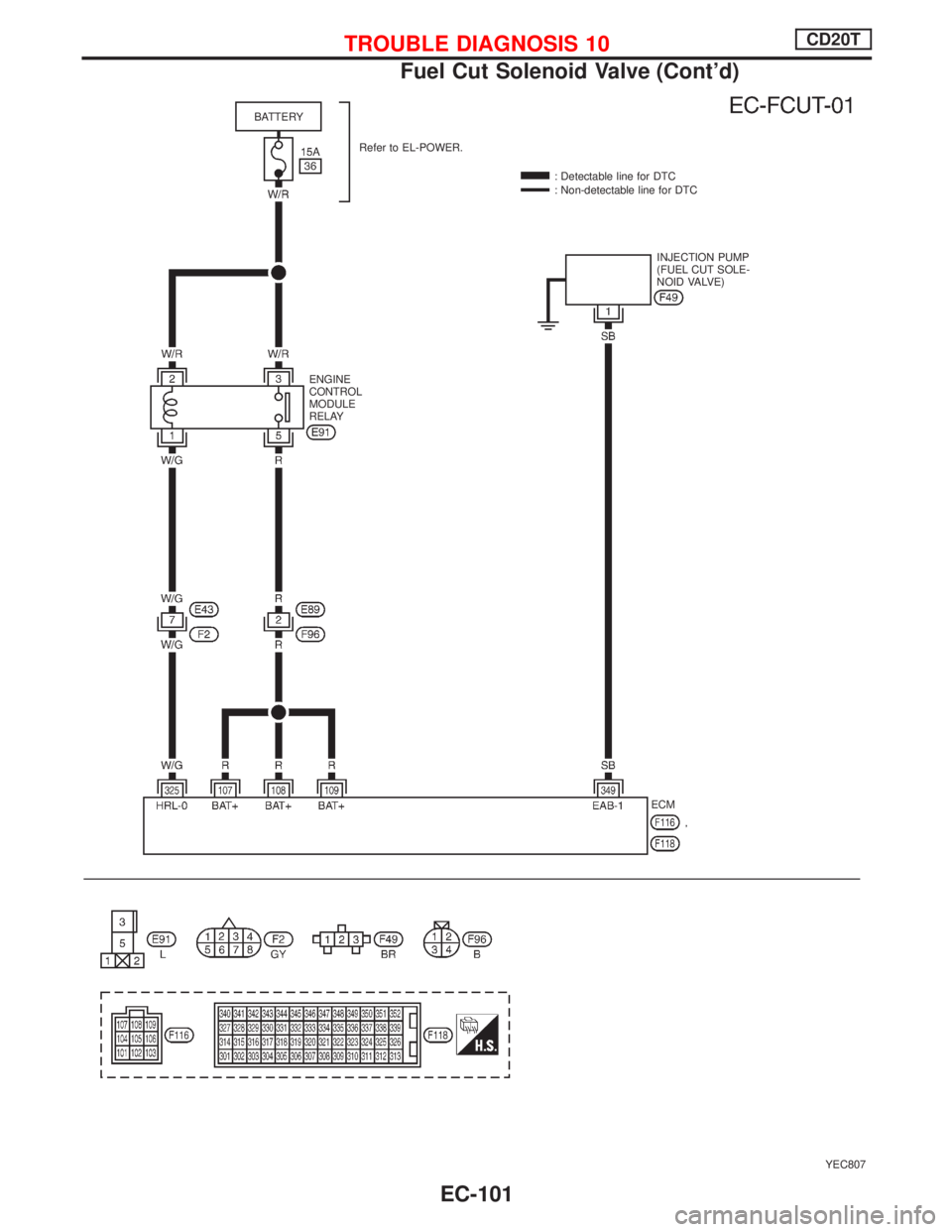
YEC807
BATTERY
Refer to EL-POWER.
: Detectable line for DTC
: Non-detectable line for DTC
INJECTION PUMP
(FUEL CUT SOLE-
NOID VALVE)
ENGINE
CONTROL
MODULE
RELAY
ECM
TROUBLE DIAGNOSIS 10CD20T
Fuel Cut Solenoid Valve (Cont'd)
EC-101
Page 396 of 2267
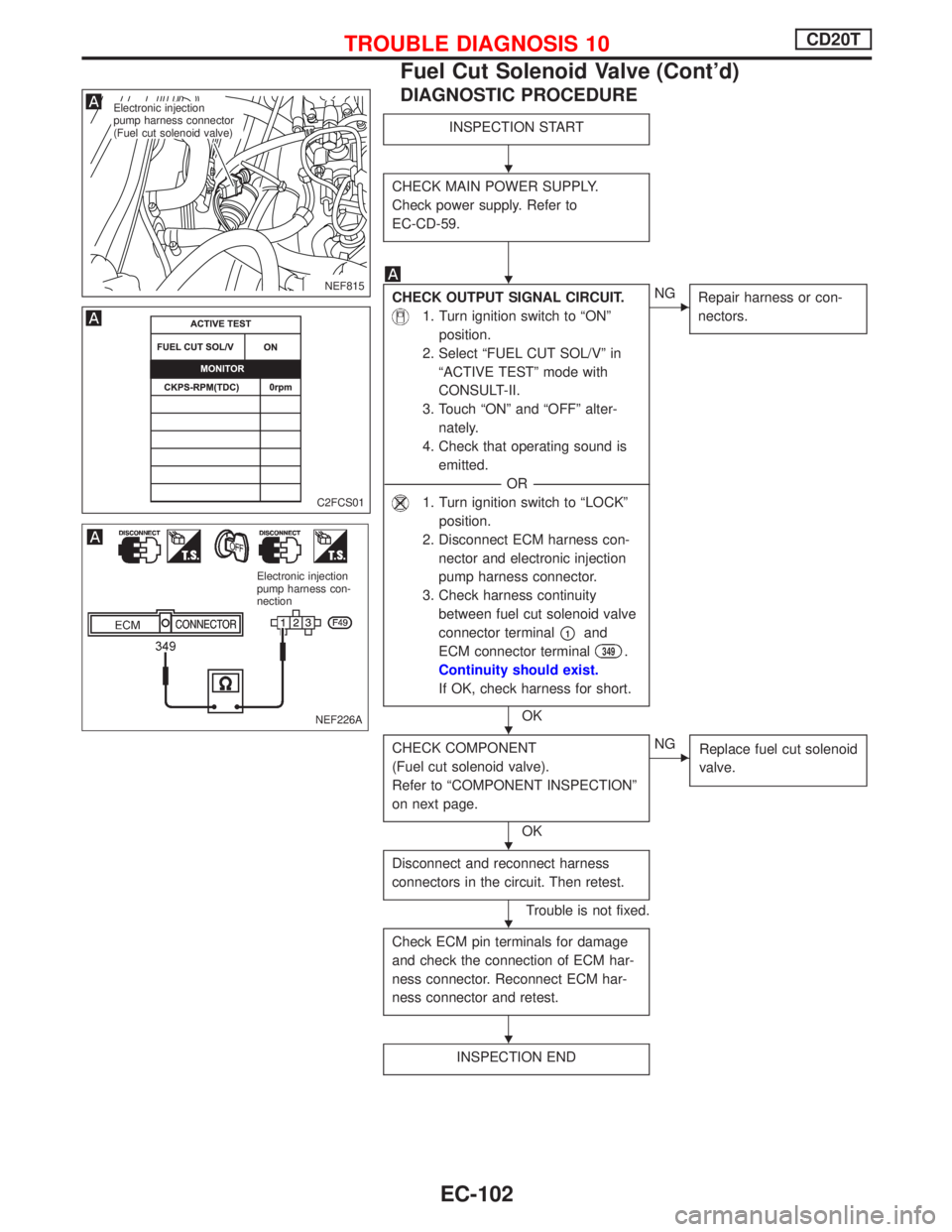
DIAGNOSTIC PROCEDURE
INSPECTION START
CHECK MAIN POWER SUPPLY.
Check power supply. Refer to
EC-CD-59.
CHECK OUTPUT SIGNAL CIRCUIT.
1. Turn ignition switch to ªONº
position.
2. Select ªFUEL CUT SOL/Vº in
ªACTIVE TESTº mode with
CONSULT-II.
3. Touch ªONº and ªOFFº alter-
nately.
4. Check that operating sound is
emitted.
---------------------------------------------------------------------------------------------------------------------------------OR---------------------------------------------------------------------------------------------------------------------------------
1. Turn ignition switch to ªLOCKº
position.
2. Disconnect ECM harness con-
nector and electronic injection
pump harness connector.
3. Check harness continuity
between fuel cut solenoid valve
connector terminal
p1and
ECM connector terminal
349.
Continuity should exist.
If OK, check harness for short.
OK
ENG
Repair harness or con-
nectors.
CHECK COMPONENT
(Fuel cut solenoid valve).
Refer to ªCOMPONENT INSPECTIONº
on next page.
OK
ENG
Replace fuel cut solenoid
valve.
Disconnect and reconnect harness
connectors in the circuit. Then retest.
Trouble is not fixed.
Check ECM pin terminals for damage
and check the connection of ECM har-
ness connector. Reconnect ECM har-
ness connector and retest.
INSPECTION END
NEF815
.Electronic injection
pump harness connector
(Fuel cut solenoid valve)
C2FCS01
NEF226A
Electronic injection
pump harness con-
nection
H
H
H
H
H
H
TROUBLE DIAGNOSIS 10CD20T
Fuel Cut Solenoid Valve (Cont'd)
EC-102